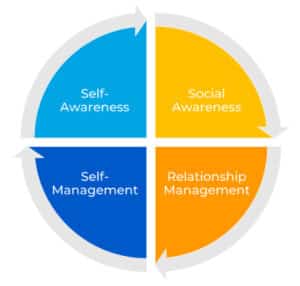
What makes the average person choose to stay or leave an organization? Is it their company’s strategic vision? Is it compensation and benefits? Is it work/life balance, or personal growth opportunities? It could certainly be any one of those, but in my experience the overwhelming reason most people choose to stay or leave an organization is the quality of the relationship they have with their direct supervisor. The question then becomes: What can we, as leaders and managers, do to make a conscious effort to positively impact the co-worker and deepen our relationship at each stage of their experience within an organization?
The answer, in my opinion, is not all that complicated. It’s just simple traits and characteristics that leaders can embody and incorporate into their everyday interactions with coworkers. Reflecting on my own early career experiences, recent opportunities to lead teams of people, and my interactions with coworkers at each stage of their career, I can assure you that modern management is not all that complicated.
Early Career Observations
Thinking back to the early part of my career, my personal desire for growth, development, and increased responsibility provides insight and shapes how I’ve chosen to manage and lead people today. During those first ten years, I had the privilege to work at several large organizations with great supervisors and mentors that helped mold how I believe an individual and an organization should function together. Through this I’ve determined that any job should be a mutually-beneficial relationship, where the coworker receives 100% of the experiences and the organization receives 100% of his or her effort. There were three key concepts that I employed as a strategy for gathering as many of these experiences as I could to improve the probability of advancing my career.
1. “Your career should be a series of three-part projects.”
In my very first job out of college I worked with a great leader who made this comment to me. He said that in the first part I should go above and beyond to learn everything about my job and anyone’s job that touches mine. In the second part I should make meaningful improvements to my role and its processes; and in the third I should ensure my improvements were lasting while beginning to look for my next challenge. I’ve learned that this three-part process may take three years, or ten years, depending on the complexity of the role, but the spirit of what he said has always stayed with me.
2. Fill your tool bag
For some reason I’ve always envisioned carrying a Craftsman tool bag with me to work. I would collect tools and place them in this bag where no one could ever take them. These tools were new skills or talents, experiences, or best practices. If a company ever decided that I was no longer needed, this bag would offer me security and the ability to market myself as someone with an eclectic array of tools that would be valuable in the future. The collection of these tools was an investment in myself, and I would never demand additional compensation after acquiring them. I would only ever ask for more challenges, not more money. The money will come from the right organization that values your tools.
3. You are your own corporate ladder
The mutually beneficial relationship between coworker and an organization only works if the organization is willing to continue to offer progressive and meaningful challenges that match the goals of the coworker, especially in the case of a high performer. Once these challenges run out, I believe you should be free to search for them at other organizations. This approach is different from past generations, where our grandparents would stay at a single organization for decades waiting to replace an open position when it finally became available. I decided that I wouldn’t allow my growth to stall, and instead chose to be my own corporate ladder where the rungs were different companies should the challenges run dry at my current one.
Developing a Management and Leadership Style
During the second part of my career, I’ve been offered management and leadership opportunities which have forced me to personally evolve and develop my own leadership style and helped me to recognize some best practices which I think work well. My current role, which I’ve had for the last eight years, has been particularly challenging and dynamic with responsibilities covering strategy, people, culture, and financial outcomes. I’ve also been tasked with managing managers, which is vastly different from managing individual contributors. When I entered this role, I quickly realized that I would need to evolve. This evolution was made possible by investing in a 360-degree assessment, an executive coach, and a multi-year journey into cognitive behavioral therapy (which I greatly recommend for anyone at any age). Out of this investment came three foundational aspects of my style that shape how I go about managing and leading on a daily basis.
1. Leverage emotional intelligence

Of the four, self-awareness is the most important to me. If you can understand yourself, you will be better able to understand others. This is you battling your ego in search of humility. I’ve struggled in this area, but the more you’re able to access your true authentic self the more apt you will be to deploy self-love and acceptance and stop buying into the hype of society. We tend to look critically at everyone else and blame them. Blame is easy; the alternative to blame is vulnerability and that’s tough. When we resent or blame someone for an unpleasant experience, we forfeit our power to change because someone else owns the result. It’s uncomfortable to learn your weaknesses, but it’s where growth occurs. Even tougher is to share those weaknesses with others. Let your coworkers know publicly when you are wrong; it lets them see that we are human and it’s ok for them to be human too.
We all face obstacles, let’s allow ourselves and our coworkers to treat them as opportunities while remembering that you are your team’s or your organization’s foundation; don’t make it a shaky one.
As leaders, the second pillar of emotional intelligence, self-management, asks us to project optimism and offer a calming presence. We all face obstacles, let’s allow ourselves and our coworkers to treat them as opportunities while remembering that you are your team’s or your organization’s foundation; don’t make it a shaky one.
The third pillar, social awareness, asks us to lead with empathy. Empathy is our ability to sense the emotions of others and allows leaders to imagine the thoughts and feelings of coworkers.
The last pillar is relationship management, and my coach always reminds me to offer “charitable assumptions”. Offering “charitable assumptions” is a mindset that assumes the best intentions of others despite the circumstances or breakdowns. Believing that we are all striving for the same outcome allows for a culture of positive conflict and respect. Progress is not possible without conflict.
2. Lead with kindness…not with fear
It’s so simple, but so often forgotten, the old school mentality of leading with fear does nothing but tear down relationships and build up walls. Kindness builds emotional capital with your coworkers and is not a weakness as many people view it to be. Using fear to control people builds up resentment and your team will leave because they are not able to offer their fullest potential in that environment. Leading with kindness and expecting nothing in return should be a rule for life not just the office.
3. Happier and Smarter
The third aspect has really become somewhat of a mantra for me. I tell everyone before they join our organization that at the end of the day my goal for them is to be happier and smarter than when we first met. As business leaders, if we can boil our decision making down to simple common denominators, like making people happier and smarter, then everything else will take care of itself. It’s also mutually-beneficial; happier people increase client satisfaction and are more productive, and smarter people make the business more effective and efficient. It’s a win-win.
Positively Impact Co-workers at Each Stage of Their Career Experience
So back to where we started—why do people stay or leave their jobs? Again, it’s their direct supervisor. In the last part, I want to offer some specific leadership traits and best practices that I believe can be beneficial to managers and leaders if employed at key milestones of the coworker’s experience including recruitment, onboarding, reboarding, performance management, personal development, and retention. As a manager or leader, you should always be asking yourself, “How can I make a conscious effort to positively impact the co-worker and deepen our relationship at each stage of their experience?”
It all begins with recruitment. This is your first opportunity to develop a deep and lasting relationship. A great leadership trait to emphasize at this stage is humility. You must humble yourself and ask where your organization is lacking and where a new hire could complement these deficits. Also be on the lookout for soft skills that don’t necessarily show up on a resume. Utilizing deep listening and curiosity during your interviews will prove valuable in your search for these soft skills. We search for stories and examples of grit, ambition, and strong EQ. I personally look for someone who compliments me or has a communication style that works for me because I want to avoid micromanagement; I’d rather pick people I believe in and empower them.
Once hired, the next stage is onboarding, which is your organization’s opportunity to make a great first impression. During this stage of employment, take the time to explain why; why this strategy, why that process, why are we in business at all. You want to explain why you are doing what you are doing, not just what you want someone to do. When a coworker understands the ‘why’ it gives them meaning and purpose. I also believe that exuding patience at this stage will benefit everyone. Let people know that failure is OK, if we choose to learn from it. To avoid failure, I’ve found that checklists are essential; no individual or team can remember everything. They help to avoid common mistakes and inconsistencies and should be short, clear, and focused on essentials. Checklists during onboarding are a great practice everyone should utilize.
Training and learning can’t stop with onboarding, though and this is where the concept of reboarding enters the equation and the leadership characteristic to utilize is alignment. This is your opportunity to realign coworkers with the organization’s expectations. You can also recapture that same good feeling that you worked to create during onboarding. It encourages them to feel engaged, welcomed, and reconnected to your organization. Revisiting expectations with existing coworkers will generate opportunities to identify gaps and additional efficiencies. Through reboarding, your employees can refocus on work that matters. In return, this exercise fosters positivity and productivity as employees become accustomed to the latest version of normal and in some cases drive continuous improvement when you learn there may even be a better way.
One of the most time-consuming activities for a leader, if done correctly, is performance management. This to me is the single most important thing you will do as a manager and takes the most time. The key here is to lead with consistency. You do not want to cut corners. Everyone wants and needs to know how they are doing and it’s important to align personal goals with strategic planning and annual operating budgets, as well as tying the meaning and purpose of their goals into the short- and long-term vision of the organization. In this stage there is no such thing as over communication. If you think you have told someone something, tell them again, and again after that. I once read somewhere that the seventh time you tell someone something will be the first time, they hear it. One of the best ways to communicate is through monthly one-on-one discussions, these are crucial—DON’T CANCEL! It’s a way to give regular consistent feedback, review goals and metrics of the individual, provide resources, address issues, and coach.
Personal development is next, and a leader would be wise to embody a service mindset. Leaders should work for their employees and not the other way around. If you increase your level of effort and performance, you’ll see your employees’ level of effort and performance increase as well. During interviews, I’ve recently found that most organizational inquiries from candidates relates to growth and development opportunities. One of the best methods to ensure a culture of growth and development is through individual development plans. We have strategic plans for the business to achieve its long-term goals and this is the coworkers’ strategic plan for their career. The process starts with a values assessment and a talent inventory of skills and certifications, and then moves into a conversation about their past, present, and future interests and motivations. The IDP results in a three-to-five-year plan that is memorialized and reviewed about every six months. This process is a wonderful opportunity to deepen your understanding of the individual, learn what motivates them and determine what you can do to meet their needs.
The last stage of employment is retention and sometimes exit. You’ve invested a lot up to this point and you want to protect that investment; you want to retain people. If along the way you’ve been self-aware, authentic, vulnerable, optimistic, calm, kind, curious, humble, patient, offered charitable assumptions, listened deeply, explained why, aligned well, stayed consistent, and operated with a service mindset, then inherently you should have a pretty good shot at increasing your probability for retention. The fact of the matter is though, sometimes no matter what you do, people leave. Typically, they’ll leave for three reasons: performance, restructuring, and/or resignation. All three reasons give you an opportunity to employ the final leadership trait and that is integrity. As a manager and leader, if you’re going to talk the talk, you’ll need to walk the walk even when it doesn’t work out in your favor.
In closing the message is simple. If you consistently and consciously care about your people modern management is not all that complicated. ◆
-
This author does not have any more posts.
Join John as he presents this content at the IPMI Leadership Summit, February 29 in Atlantic Beach, Florida. Limited seats are still available, click here to register today!
Table of Contents


Diversity, Equity, & Inclusion
Impactful and Sustainable Corporate Culture Must Be Supported by a



The Power of Mentorship in Every Business
When organizations comprise themselves of leaders that possess the ability









